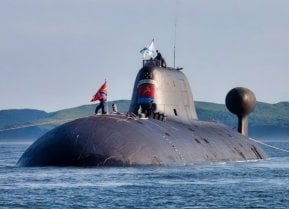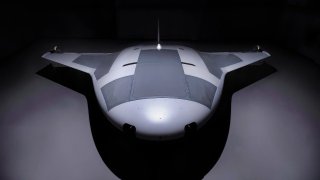Northrop Grumman's Manta Ray Could Change Undersea Warfare Forever
Northrop Grumman describes the new Manta Ray drone as: “A new class of UUV, it is an extra-large glider that will operate long-duration, long-range and payload-capable undersea missions without need for on-site human logistics.”
This could help to address one of the biggest challenges facing any deep-sea platform whether crewed or uncrewed – communications.
Military platforms that operate on or above the surface rely heavily on radio communications, but radio waves cannot penetrate the oceans’ highly conductive salt water. As a result, America’s nuclear ballistic missile submarines rely on Very Low Frequency (or VLF) transmissions relayed via massive sprawling antenna complexes positioned in five installations around the world. If those stations are taken out by enemy attack, a fleet of specially-equipped TACAMO (Take Charge and Move Out) aircraft will deploy five-mile-long antennas then fly in tightly overlapping circles above the ocean to transmit what effectively amounts to a text message to submarines deep beneath the waves.
Manta Ray may be equipped for VLF communications as well, but due to the inherent limitations associated with these sorts of transmissions, the “data bubbles” released from Thermal Energy Pods could provide a simple means of standard communications at regular intervals.
This also means that an uncrewed submarine meant for extended-duration missions needs to be able to operate largely autonomously, with very little direct interaction with the world above. As such, Manta Ray will need to adopt, or adapt, some means of autonomous control, potentially through the use of AI.
Power production is far from the only challenge Manta Ray needs to overcome in order to have a palpable strategic impact on maritime defense. Novel solutions for corrosion control, undersea obstacle avoidance, and the extreme degree of reliability required for extended operations in such unforgiving environments also need to be developed.
MANTA RAY COULD PROVIDE A BIG BOOST TO ANTI-SUBMARINE WARFARE
While there are several potential military and scientific applications for Manta Ray, one strategically valuable place to start might be in countering adversary submersibles – specifically, those armed with nuclear weapons.
Despite Russia’s poor performance throughout the ongoing invasion of Ukraine, Russia’s undersea capabilities remain among the best in the world, and as such, represent a potent threat to American security. Currently, Russia operates two classes of nuclear-armed ballistic missile submarines, including five Delta IV submarines and eight Borei-Class vessels of different iterations. Despite Russia’s sanction-based economic woes, production continues on three additional modernized Borei-A-class vessels. Russia’s Status-6 Oceanic Multipurpose System, also known as Poseidon or Kanyon, is a high-speed nuclear torpedo designed to travel distances as great as 5,400 nautical miles (6,200 miles) at speeds as high as a claimed 54 knots (a shocking 62 miles per hour), before lying in wait inside enemy harbors, waiting for the command to detonate its nuclear payload.
Initial Russian claims suggested that Status 6 could carry a massive 50-megaton nuclear payload, though that has since been revised to a more realistic two megatons. Nonetheless, a two-megaton blast would still be roughly 100 times larger than the atomic bomb dropped on Hiroshima. There remains some debate about whether or not such a detonation could create an irradiated tidal wave, with recent analyses largely disregarding the potential for this threat. Yet, such a detonation inside an American harbor would, nonetheless, be catastrophic.
This threat is more potent than many realize. In 2017, a Russian military documentary series alleged that a fleet of Russian Shchuka-B-class submarines armed with long-range cruise missiles was dispatched with orders to take up positions just outside American ports with U.S. Navy installations. The Russian Navy claimed to have completed the mission successfully, saying that they managed to operate just outside American territorial waters (extended 12 nautical miles to sea) without being detected.
The United States did not publicly respond to Russia’s claims — and likely for good reason. Had the Pentagon dismissed the Russian claims as false, Russian information operations would have spun that as tacit confirmation that America was unable to detect their presence. If the U.S. Navy did indeed detect and track the presence of these Russian submarines, revealing that could inadvertently provide some indication as to just what sorts of detection capabilities the United States does have, which may prompt renewed investment from the Russian Navy to find ways to circumvent it.
But regardless of the claim’s truth, the U.S. Navy took the threat seriously. Shortly after Russian officials made this claim, Secretary of the Navy Richard V. Spencer announced the United States was re-establishing its North Atlantic-based 2nd Fleet specifically to counter emerging Russian threats.
This decision echoed sentiments published two years prior by then-Naval Forces Europe commander Adm. James Foggo III.
“Russian submarines are prowling the Atlantic, testing our defenses, confronting our command of the seas, and preparing the complex underwater battlespace to give them an edge in any future conflict,” Foggo wrote in U.S. Naval Institute’s Proceedings. “Not only have Russia’s actions and capabilities increased in alarming and confrontational ways, its national-security policy is aimed at challenging the United States and its NATO allies and partners.”
Since then, the U.S. has also renewed investments into new forms of submarine detection, with new efforts like the Persistent Aquatic Living Sensors (PALS) program starting in 2019, which aims to use track natural and “modified” aquatic sealife near shore to use their behavior to identify the presence of encroaching submarines. Other efforts, like the Anti-Submarine Warfare (ASW) Continuous Trail Unmanned Vessel (ACTUV), which aims to field semi-autonomous submarine-hunting surface ships, that were already underway have also seen renewed interest and investment.
Northrop Grumman’s new Manta Ray system could be an incredibly potent new addition to America’s growing anti-submarine arsenal, providing a sustained weaponized presence that’s all but impossible to detect while inactive. Once submarine activity is identified via any one of the various sensing methods, automated responses in the form of both surface and subsurface platforms would take action immediately, making it harder than ever to sneak a submarine (or nuclear torpedo) in American or allied harbors.
To that end, DARPA is not placing all its eggs into Northrop Grumman’s basket: according to recent statements from DARPA, they will continue to mature other Manta Ray platforms in development.
“Manta Ray performers have each taken unique approaches to solving the wide range of challenges related to UUV endurance,” program manager Commander Kyle Woerner, said in the statement. “To me, this is a clear sign we are tackling a complex problem without a clear ‘one size fits all’ solution.”'
About the Author: Alex Hollings
Alex Hollings is the editor of the Sandboxx blog and a former U.S. Marine that writes about defense policy and technology. He lives with his wife and daughter in Georgia.
This article was first published by Sandboxx News.


